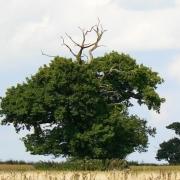‘One of my earliest visual memories was of trees.’
Leading landscape and rural photographer Charles Sainsbury-Plaice has his eyes closed and face scrunched, trying to recall his earliest memory of all things arboreal. ‘It was those sets of cards you used to get in boxes of tea. They were illustrations of British native trees, and I was captivated by the shapes and numerous varieties.’

Growing up on a bustling farm nestled in the serene landscapes of north-east Hampshire, Charles was immersed in the embrace of nature’s beauty from the outset. At the age of six, his mum’s Kodak Instamatic was discovered, and the fledgling photographer was clicking away at anything that moved or looked nice on the farm. By the age of eight, Charles had saved up and bought a Polaroid camera, which, although expensive, produced results far quicker. He continued to feed his early passion by taking images of the people, animals, landscapes and trees on their Hampshire farm throughout his childhood and teens.
‘My earliest recollection of photographing trees was at the age of 17, when I had just passed my driving test,’ he says. ‘I drove up to Watership Down, near Newbury, to photograph a majestic line of beech trees skirting an ancient chalk and flint track at the top of the hill. Standing beneath the canopy of beeches, I have a visceral memory of my mind alive with the images of who might have walked and lived under these trees throughout history. Whenever I go to LadIe Hill, I am reminded of this seminal moment, and I always reflect on what is the profound connection between past, present and the timeless beauty of nature.’

The early years of Charles’ career saw him travel all over the UK in a sales role for a leading agricultural plant breeder, while also taking photographs for some clients. Realising he was developing a good eye for something he loved to do, he decided to take the plunge and focus on a solo career in photography. A proactive approach led to one of his first jobs being for the then Prince of Wales, prompting the start of decades-long work for the now King and the Duchy of Cornwall. Charles has documented many visual moments of The King’s work for the Duchy of Cornwall, much of which has involved some aspect of forestry, woodland management, and many a walk through woods, both old and new.
It was along this journey that Charles had the good fortune to get to know Geraint Richards, head forester for the Duchy of Cornwall. ‘I love working with Geraint,’ he says, ‘he is such an inspiring person, so passionate and knowledgeable about his subject. You could listen to him for hours and not get bored. I suppose it was really Geraint who turned my developing interest in trees into total fascination.’

Other Cotswold trees featured in the QGC include the Colesbourne oriental plane, and Lower Woods in Wickwar. The oriental plane tree is a fantastic example of this large and spreading tree, with a short trunk, flaking bark and twisted branches that come right down to the ground. Cultivated by Henry John Elwes, the published tree specialist who not only travelled the British Isles to document all hardy trees, but also to China, where he took a cutting of the plane tree from a Chinese emperor’s tomb in 1901. It is said that he wore out two motor cars in his work to document tree species.
When Geraint, in late 2021, approached Charles and asked him if he’d like to be involved in a project he was working on for the Platinum Jubilee, there was no hesitating in his reply. Alongside fellow arboreal photographer Adrian Houston, together they embarked on a year-long journey to capture images for this historic and exciting venture. The Queen’s Green Canopy (QGC) was a unique tree-planting initiative, created by the charity Cool Earth to mark Her Majesty’s Platinum Jubilee in 2022. The initiative invited people from across the United Kingdom to “Plant a Tree for the Jubilee” and create a legacy in honour of The Queen’s leadership of the Nation. Everyone from individuals to youth groups, villages, cities, counties, schools, and corporates were encouraged to play their part to enhance our environment by planting trees.

The QGC dedicated a network of 70 ancient woodlands across the United Kingdom to celebrate Her Majesty’s 70 years of service. In total, over 3 million trees were planted across the UK. ‘An important part of the project was to travel the length and breadth of our four British nations and to document the 70 ancient trees and woodlands to be dedicated to her late Majesty,’ says Charles.
Charles encountered many memorable occasions when gathering images for the book. One such was photographing the Llangernyw Yew in a churchyard in North Wales. ‘As a child I remember being told that yews were planted in churchyards so that archers could make bows from them. My love for them has grown stronger and stronger the more I have learnt about the stories behind them.’ The Llangernyw Yew is said to be anywhere between 3,000-4,500 years old, which predates Christianity and possibly puts it being around at the time they were building the outer circle at Stonehenge.

Yew trees were considered sacred by pagans and closely associated with death and rebirth. When Christianity came along, it made complete sense to build churches on these sites in order to stamp out ungodly practices. Yew trees were also important boundary markers back in the times before fences, purely because nothing would eat them, and quite often you see old ones dotted around in hedgerows. The church yard at Painswick is a fantastic example of decorative yews, boasting in total 99, all planted in the 18th century.
One of the most iconic images in the QGC is that is St Edward’s yew, found at St Edward’s Church in the heart of the Cotswolds in Stow-on-the-Wold. Not one, but a pair of trees flank each side of the church door, and it is widely considered that JRR Tolkien was inspired by this sight for his drawing of the Doors of Durin featured in The Lord of the Rings, since the resemblance is very strong. Tolkien used to visit a local pub with his friends while he was Professor of Old English at Oxford, and it’s very possible that he gained inspiration by the gnarled trees that are so old they appear to be part of the church stonework.

The Scots pine is another native tree species that has captured Charles’ interest. ‘What I find fascinating is the use of the Scots pine through history as a mark tree, planted as navigational aids through the centuries. On the horizon of a hill, the Scots pine has a distinctively different canopy to most other trees and therefore can be recognised at long distances. They were quite readily planted on drovers’ routes and other ancient tracks. When you are travelling around the country, look for single or clumps of Scots pines. More often than not, they will be on a bridleway, byway or old road. I have found several stunning old tracks on Exmoor using Scots Pines as siting marks.’
The oak is without doubt an exemplary native tree to the UK. Brocton Coppice in Staffordshire is an impressive spread of ancient oak woodland. The 500-year-old Sessile oaks are said to have also inspired Tolkien. ‘I was fortunate enough to visit Brocton Coppice on a beautiful June afternoon with the intention of staying in the wood until it was dark,’ says Charles. ‘A lot of images can be taken when it is dark, so long as you have a steady tripod, a good torch and preferably a still night. I love using a technique whereby you set the camera up on a very long exposure in the dark (as much as four or six minutes) and then literally paint the side of the subject with torchlight. The effects can be amazing, but more importantly you get to spend time in a wood on your own at night, and they are indeed magical places at these times. One important thing to remember, though, is to geo-tag where you park your car, because getting lost in a wood at night, as I have done, is not much fun when you realise you have walked in circles for hours and past the car park five times!’
Ancient tracks are a phenomenon that also piques Charles’ fascination with rural landscapes.
‘While photographing the ancient wood at Pentre Ifan in Pembrokeshire, I had a profound experience. After a long walk and rocky climb, I encountered a woodland panorama. I felt a rich connection with the exquisite view, enhanced by the sounds of nature and a rich sunset. This moment inspired me to venture into the woods that I had seen, and it was there I discovered an ancient sunken track which has inspired me to continue to search out these age-old paths. Ancient tracks are my current focus, and I am crafting some exciting projects around this subject.’
Signed copies of The Queen’s Green Canopy are available signed from countrysidegreetings.co.uk and also from most high street booksellers. A range of limited-edition framed prints from the book are also available from thetreeartgallery.com




























